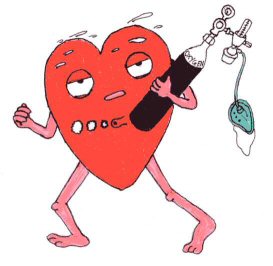Oxygen Delivery - DO2
The prime function of the circulation is to deliver oxygen and nutrients to the tissues and to remove waste products from them. If we know the cardiac output and the patient's haemoglobin level and oxygen saturation, then we can calculate one further critical value in hemodynamics - the oxygen delivery to the body or DO2.

One gramme of haemoglobin can carry 1.34 ml of oxygen as oxyhaemoglobin. If we know how many grammes of haemoglobin the patient has per litre of blood, what proportion of the haemoglobin is saturated (carrying oxygen), and how much blood the heart pumps each minute, then we can calculate easily the oxygen delivery to the tissues. (The small amount of oxygen carried in solution in plasma can be ignored as this represents only about 2% of the total.)
DO2 = 1.34 x Hb conc. x Cardiac Output x (SaO2/100)
SaO2 should strictly be measured from an arterial blood sample, but pulse oximetry gives us SpO2 which is an acceptable surrogate for SaO2. We can then revise our formula to:
DpO2 = 1.34 x Hb conc. x Cardiac Output x (SpO2/100)
It probably won’t come as a surprise to learn that the USCOM is soon to have its own plug-in pulse oximeter probe, with a data input screen to allow the user to enter the patient’s haemoglobin concentration. The USCOM then performs the calculation above and voila - DO2! (Well OK, DpO2 to be pedantic.)
So what kind of values do we get for DpO2 in normal patients? If we take a normal haemoglobin level as 150g/L and a normal SpO2 as 98% then if the CO is 5.5L/min, the calculation is
DpO2 = 1.34 x 150 x 5.5 x 98/100 = 1,083 ml / minute
This is a typical value for an adult, but what figures should we use for our neonate or indeed our prop forward? In just the same way that we used cardiac index instead of total cardiac output to compare patients of differing sizes, so we can substitute cardiac index in place of cardiac output in the equation above, to give us oxygen delivery index or DpO2I. Taking a typical cardiac index as 2.4 – 3.2 L/min/m2 and inserting this into the calculation we get
DpO2I = 1.34 x 150 x (2.4 to 3.2) x 98/100 = 473 to 630 ml / minute / m2
From the above we can say that a DpO2I of 500 – 600 ml/min/m2 is where we should be aiming in an adult. The comparable figure for a child, due to their high CI values, would be more like 700 - 850 ml/min/m2.
If you want to scare yourself, try doing the calculation for someone who is anaemic, with a low CO or CI and then add in reduced oxyhaemoglobin saturation. Suddenly we see why hemodynamics matters in this most fundamental of the circulatory functions. Hemodynamics and DO2 are quite literally vital. Not only does the USCOM ensure that we can keep the hemodynamics in the correct range and keep the patient vital (i.e. alive!), but it takes the guesswork out of a critical area of medicine where guesswork is no longer acceptable.
|

